Bury Corporation Tramways
History
Bury Corporation's plans for a municipal electric tramway system were well advanced by 1904, but were held up by a delay in acquiring the lines of the Bury, Rochdale and Oldham Steam Tramways Company. This company had an extensive steam tramway system (which ran on two gauges in Bury, standard and 3ft 6ins) encompassing Whitefield, Bury, Heywood, Rochdale, Royton and Oldham. Oldham had taken control of its lines (which it had always owned) in June 1902, but it was not until the 24th February 1904, that a binding agreement was finally reached — between the various local authorities and the company — on handing over the tracks and assets, and even then, the price the authorities would have to pay was still to be determined.
This agreement allowed Bury to take control of the tracks within the town, as well as those in Tottington and Unsworth, and begin the conversion to standard-gauge, overhead electric traction; meanwhile, the company continued to operate steam services whilst its lines were converted, one by one. The first electric services commenced on the 3rd June 1903, with the last steam service (a special) running on the 10th July 1904.
Bury also reached agreement with neighbouring Radcliffe Urban District Council and Heywood Corporation to work their tramways once constructed. Negotiations with Heywood were however somewhat fraught, including an impasse which saw Heywood operating the old steam trams for 11 months, the Bury electric cars stopping at the municipal boundary from the 21st April 1904 until the 17th November 1905, when the newly converted extension to Heywood was finally opened.
Although Bury had held powers to run buses since the Edwardian era, it did not take advantage of these until 1925, when it introduced its first services, largely in response to unregulated bus competition from private operators; the bus services were quickly expanded, and in 1927, powers were obtained to operate buses beyond the confines of the municipal boundary. These services were initially set up as part of an integrated tram-bus network, feeding the trams and running to destinations not served by them, though they soon started to run along some tramway routes, which undoubtedly impacted the latter's viability. The name of the enterprise was changed sometime in 1932 — to Bury Corporation Transport — to reflect increasing contribution of the buses.
Rochdale, which together with Bury, operated Heywood Corporation's tram services, closed its own system in late 1932. Bury Corporation formally decided to abandon its tramway on the 13th March 1933, but in a less precipitate manner than Rochdale, i.e., as and when leases expired or the tramway track became due for renewal. Whilst the entire system would probably have been abandoned by the late 1930s (the last tram over Radcliffe UDC tracks having run on the 8th October 1938), the Second World War led to a postponement, the last Bury tram finally running on the night of the 13th February 1949.
At its maximum, the system extended to 23.76 miles of tramway, 14.34 miles owned by Bury Corporation, 6.12 miles by Radcliffe UDC, 0.32 miles by Whitefield UDC and 2.98 miles owned by Heywood Corporation. The system comprised lines: northwestwards to Tottington; northwards to Walmersley; northeastwards to Jericho; eastwards to Heywood and Hopwood; southwards to Whitefield; as well as Radcliffe UDC's lines to the southwest.
The tramway also met the lines of Bolton Corporation Tramways (at Breightmet), Salford Corporation Tramways (at Whitefield) and Rochdale Corporation Tramways (via the Heywood Corporation system). Inter-running agreements were reached with Bolton and Rochdale Corporations, which saw Bury cars appear in the latter two towns and their cars in Bury. Agreement was also reached with Salford Corporation for the BCT to operate services to Whitefield; it was not however until the 4th January 1926 that a through service between Bury and Salford was implemented, which saw SLT cars in Bury and BCT cars reach Victoria Bridge in Salford. When Manchester Corporation Tramways financed and built an extension from Middleton to Hopwood (opened on the 19th May 1928), Bury participated in joint-running on the new line between Heywood and Manchester (as one of the operators of Heywood's tramways). Although this saw Bury cars reach High St in Manchester, the service was short-lived, Bury's involvement ending on the 19th February 1933.
Uniforms
Photographs of Bury Corporation Tramways staff are surprisingly rare, much more so than those of its predecessor, the Bury, Rochdale and Oldham Steam Tramways Company. Surviving photographs do, however, show that for the inauguration of electric services (in 1903), both motormen and conductors were issued with single-breasted jackets with five buttons, two breast pockets (with buttons closures), stand-up collars, and epaulettes; the latter carried a small brass municipal-device badge on each side. The collars carried an employee number on the bearer's left-hand side, and system initials — 'B C T' — on the right-hand side; these were embroidered at first, and in script-lettering, but were quickly superseded by brass initials badges (in individual letters and numerals).
The tensioned-crown peaked caps and carried an elaborate brass cap badge comprising the Bury municipal arms and motto, all within a wreath, and with the full system title — 'BURY CORPORATION TRAMWAYS' — in a ribbon beneath.
A photograph from the 1920s shows a motorman wearing a double-breasted, lancer-style tunic with five pairs of buttons (narrowing from top to bottom) and stand-up collars, but without epaulettes. It is unclear when these tunics were introduced, nor whether they were used exclusively by motormen. Given that several examples of nickel 'BURY CORPORATION TRAMWAYS' cap badges have survived, the insignia (badges and buttons) were presumably changed from brass to nickel at some point, possibly in the 1920s or 1930s. The name of the department was changed to 'Bury Corporation Transport' in 1932, so it is highly likely that the insignia were changed to reflect the new title in the 1930s or 1940s. The new cap badges, which were chrome, were virtually identical to the old cap badges, differing only in the title in the ribbon: 'BURY CORPORATION TRANSPORT'.
By the 1940s, tramcar staff were wearing a more modern style of double-breasted jacket with four pairs of buttons, lapels and epaulettes. Photographs suggest that the epaulettes bore the standard Bury municipal-device badge, though a publicity shot has survived (see below) which also shows 'B C T' system initials being worn; the latter may, however, depict a bus man as opposed to a tramway man. It is also possible that at the very end of services, a one-piece, chrome 'BCT' badge was worn; however, this is far from certain, and its use may in fact post date the demise of the tramway.
Tramcar staff were also issued with double-breasted greatcoats with five pairs of buttons and high, fold-over collars; it is unclear whether these garments bore badges of any kind.
Photographs of senior staff are very rare, with only a shot of Chief Inspector Williams really close enough to discern the general style of uniform worn. Extrapolating from this photograph, it is highly likely that inspectors wore typical tramway senior staff uniforms, namely: single-breasted jackets with hidden buttons (or more likely a hook and eye arrangement) and stand-up collars, all edged in a finer material than the main body of the jacket; the collars would have borne the grade — 'Inspector' — in embroidered script lettering, on both sides. Headgear would have taken the form of a tensioned crown peaked cap, again bearing the grade — 'Inspector' — in embroidered script lettering, but on a hat band.
In common with the vast majority of UK tramway systems, Bury employed female staff during the Great War — as conductresses, and possibly, though not certainly, as motorwomen too — to replace men lost to the armed services. It is currently unclear what tunics/jackets these ladies wore, as the sole surviving photo (see below), shows them in double-breasted, lancer-style greatcoats with five pairs of buttons (narrowing from top to bottom), and with epaulettes (fastened with a button at the neck end) and stand-up collars. Both the collars and the epaulettes were left plain, i.e., they were devoid of badges. Headgear took the form of a bonnet, either felt or waterproofed, which bore the standard 'tramway' cap badge on a hat band.
Bury almost certainly employed female tramcar staff during the Second World War, however, photographs have yet to surface, so details of the uniforms they wore remain unknown.
Further reading
For a history of the system, see: 'Tramways in Bury' by E Hall and T Young; Light Rail Transit Association (2017).
Images
Motormen and conductors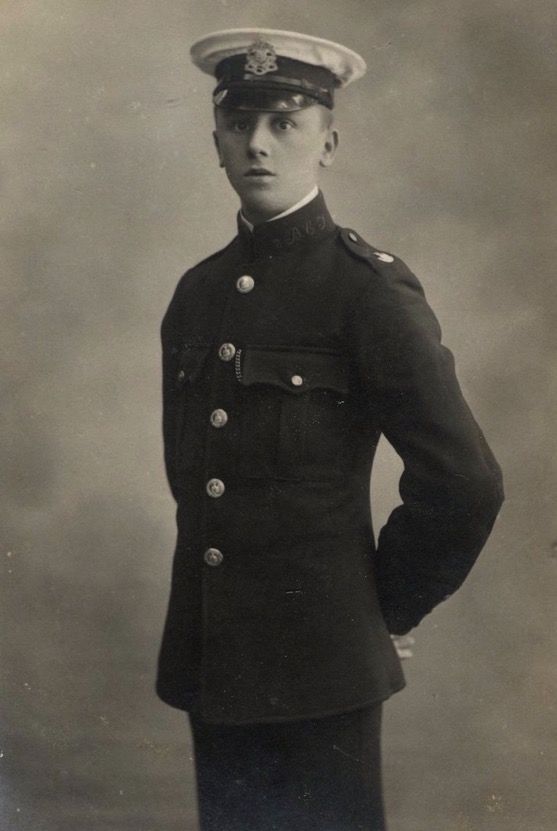
A rare studio portrait (by Venn & Payne of Bury) of a Bury Corporation Tramways employee — photo undated, but almost certainly early Edwardian (1903/4). Author's Collection.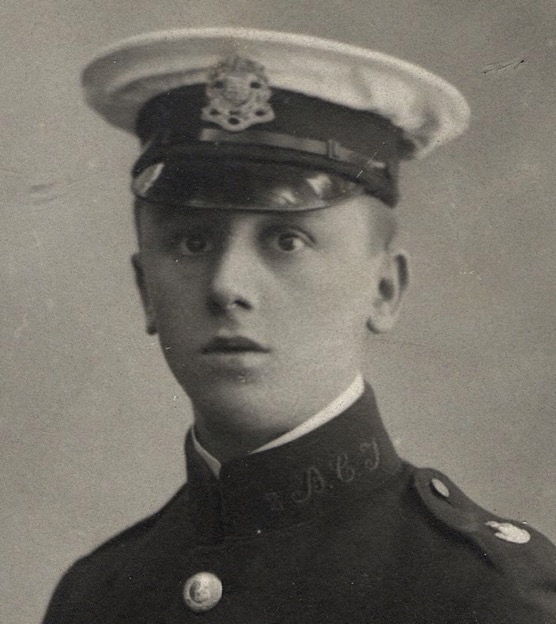
An enlargement of the above photograph showing details of the cap, collar and epaulette insignia. The collars, which are unusually tall, bear embroidered system initials, 'B C T' on the bearer's left-hand side (in elaborate script lettering) and an employee number on the right-hand side (not evident in this photo). The system initials are preceded by an unidentified character, which may simply have been an elaborate flourish. 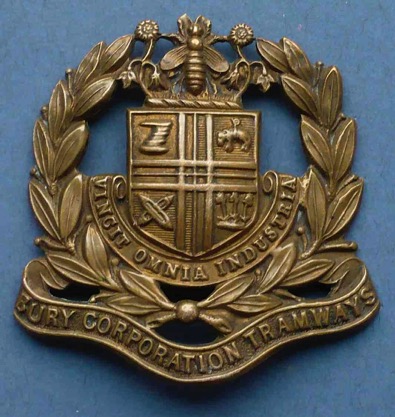
Bury Corporation Tramways cap badge — brass. Author's Collection.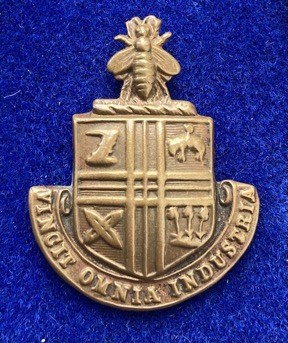
Bury Corporation Tramways epaulette badge — brass. Author's Collection.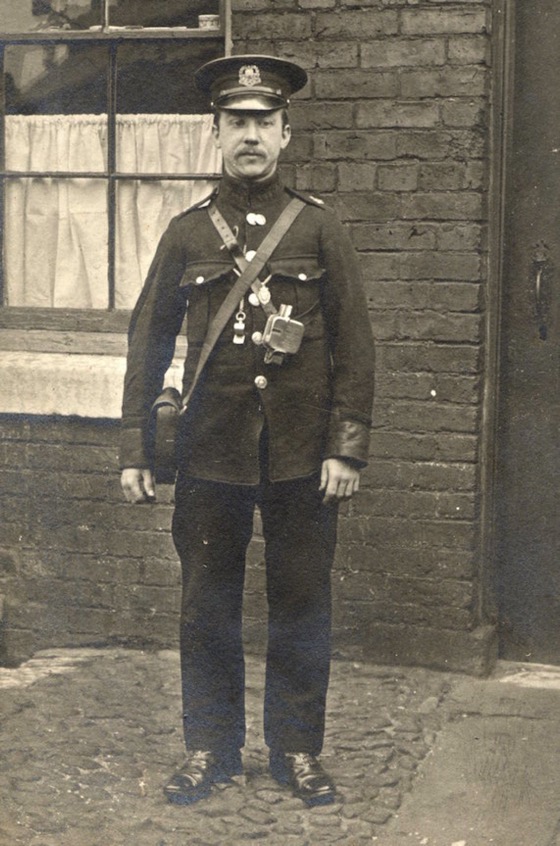
A Bury Corporation Tramways conductor — photo undated, but probably early Edwardian. Author's Collection.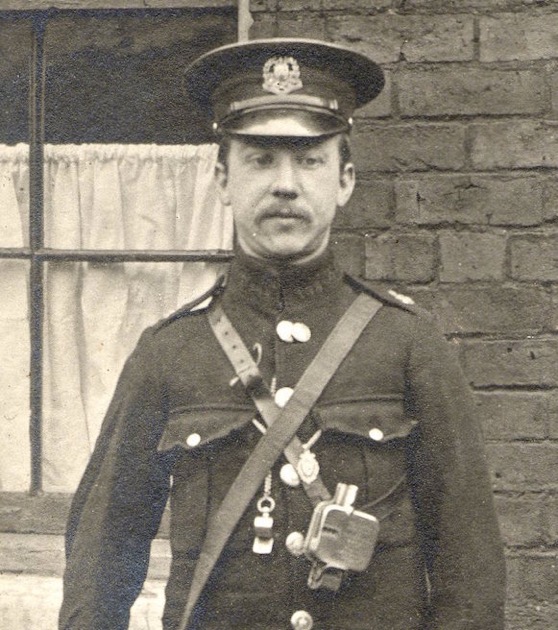
An enlargement of the above photograph showing details of the uniform and insignia.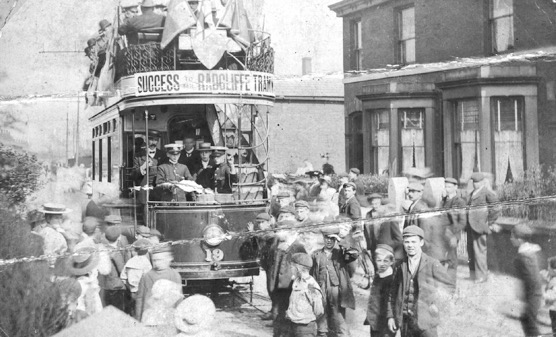
Tramcar No 17, captured on what is almost certainly the inaugural electric service in Radcliffe on the 24th June 1905. With thanks to Bury Image Bank (see link); Image b04963 — copyright Bury Archive Services.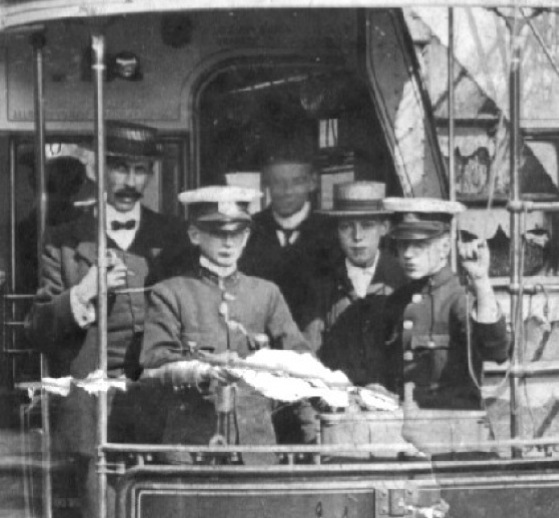
An enlargement of the above photograph showing the rather boyish-looking motorman and conductor in their single-breasted jackets. The former has metal 'B C T' initials on his right-hand collar, whilst the latter has an employee No — '4' — on his left-hand collar.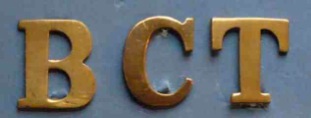
Bury Corporation Tramways collar initials — brass. Collar insignia appear to have been embroidered initially, but seemingly soon gave way to brass numerals and letters. Author's Collection.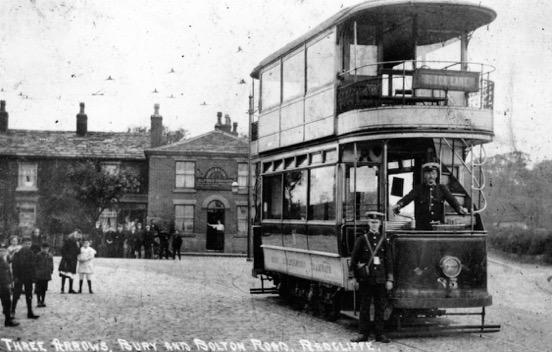
Tramcar No 35 captured for posterity outside the Three Arrows Public House, Bury and Bolton Rd, Radcliffe — photo undated, but given the pristine condition of the tram, probably taken in late 1905 when it was delivered. With thanks to John Holme of the Manchester Transport Museum Society.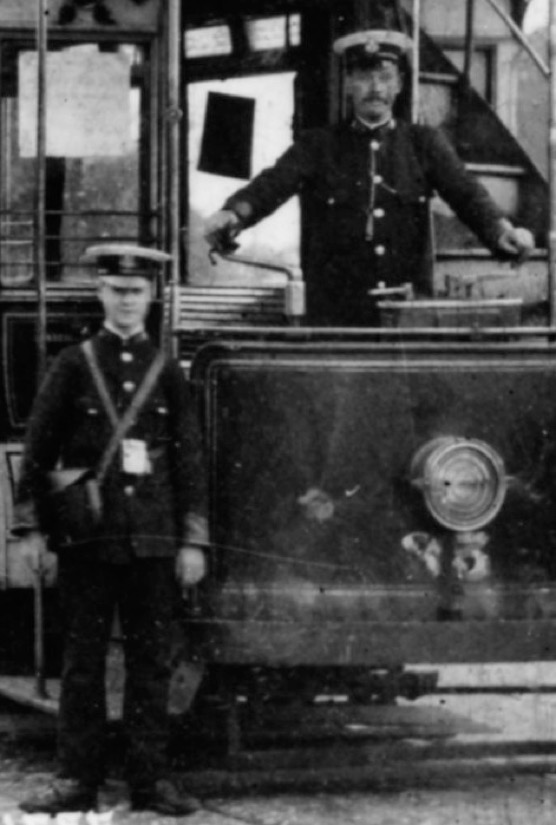
An enlargement of the above photograph showing the conductor and the motorman.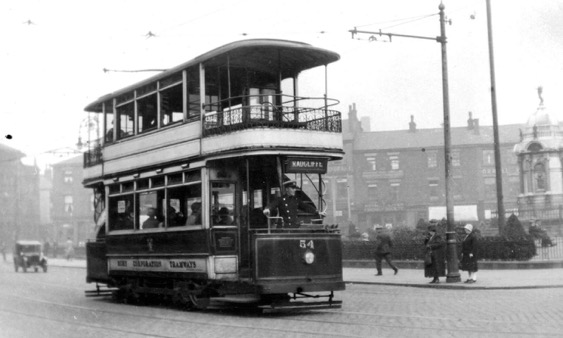
Tramcar No 54 heading towards Radcliffe — photo undated, but probably taken in the late 1920s (No 54 was withdrawn in 1932). Photo courtesy of Duncan Holden.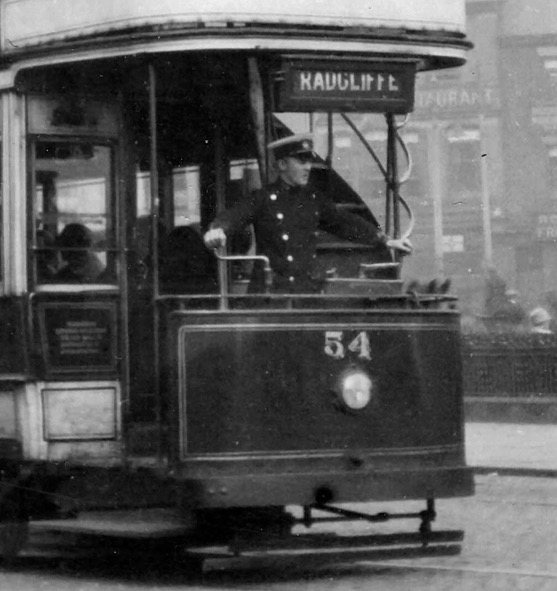
An enlargement of the above photograph showing the motorman, who is clearing wearing a double-breasted, lancer-style tunic.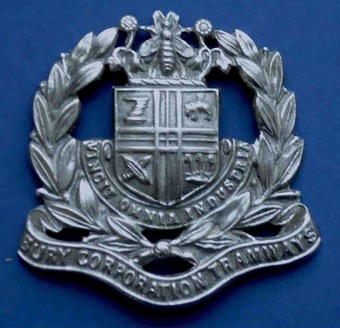
Bury Corporation Tramways cap badge — nickel. Badges in this material were probably introduced in the 1920s or 1930s, though evidence for a precise date is currently lacking. Author's Collection.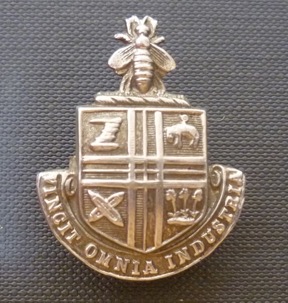
Bury Corporation Tramways epaulette badge — nickel. Badges in this material were probably introduced in the 1920s or 1930s, though evidence for a precise date is currently lacking. Author's Collection.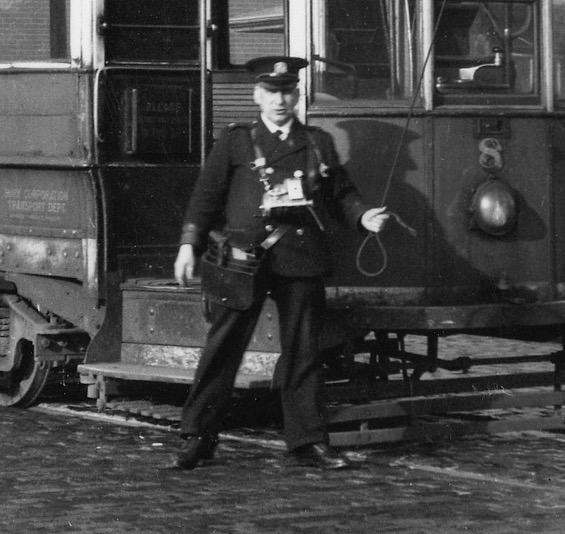
The conductor of Bury Corporation Transport Tramcar No 8, who is in the process of turning the trolley pole, poses for the camera of A D Packer on the 9th October 1948. Author's Collection.
Bury Corporation Transport cap badge — chrome. New issues of tramway uniforms probably bore 'Transport' insignia from the mid 1930s onward. Author's Collection.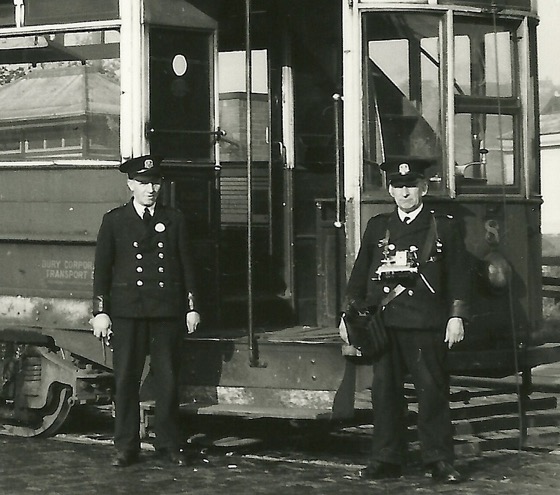
A motorman and a conductor with Tramcar No 8, which has clearly seen much better days — photo undated, but possibly taken on the same day as the previous photograph given that the tram and the conductor are both the same. The driver is wearing a round PSV badge, suggesting that he may also have been a bus driver. Photo courtesy of the Stephen Howarth Collection.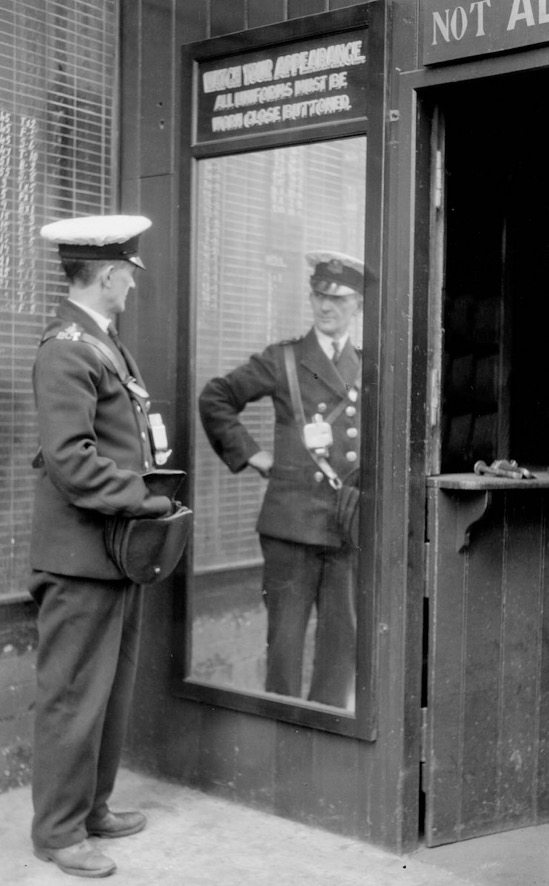
A Bury Corporation Transport conductor with what is probably a posed publicity shot — photo undated, but probably taken in the 1950s. The epaulette insignia comprise individual 'B C T' initials and a Bury municipal device badge. The subject is more than likely a bus conductor. With thanks to the National Tramway Museum. 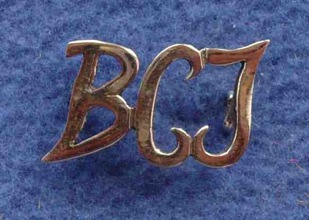
Probable post-tramway-era lapel badge — chrome. Author's Collection.
Senior staff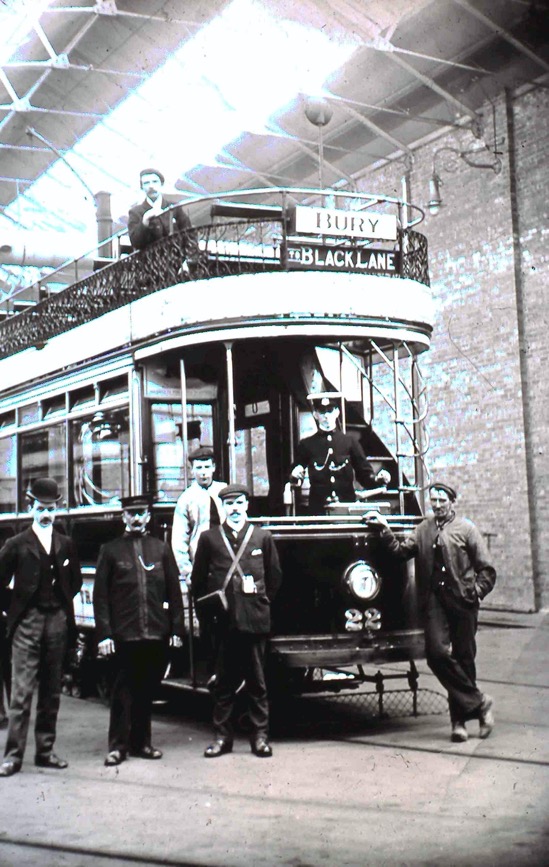
A scene taken inside the depot in 1904/5 with Tramcar No 22, clearly brand new, and various senior staff, including the Manager, Mr W Clough (left), Chief Inspector Williams (second from the left) and the Depot Foreman Mr Heyes (on the top deck). Photo courtesy of the Tom Fish Collection, with thanks to Tony Young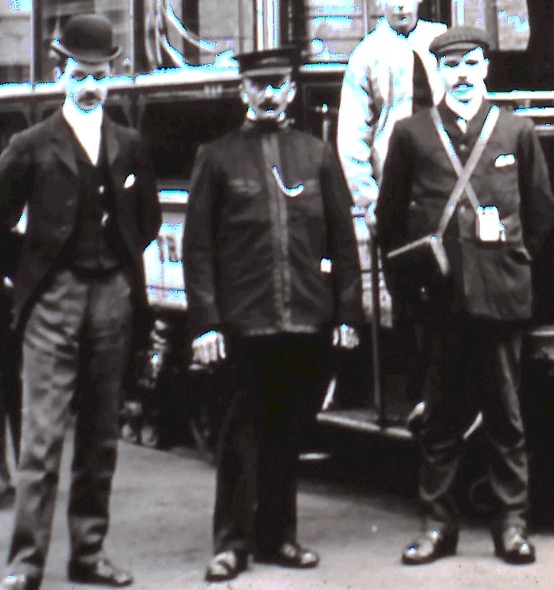
An enlargement of the above photograph showing Chief Inspector Williams, which whilst not sharp, does show the style of uniform worn.
Female staff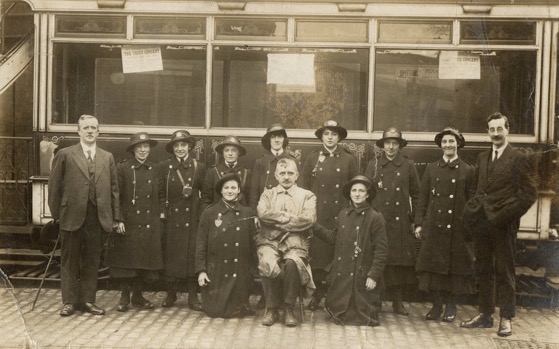
A rare portrait of a group of Bury Corporation Tramways Great War conductresses. The man seated in the centre is Albert Barlow Hayes, who was the Depot Superintendent in 1911, and eventually became Works Superintendent (with thanks to his great grand-daughter, Lisa Edwards, for this information). The poster in the left-hand window advertises a concert that was to take place on the 26th February 1918. Author's Collection.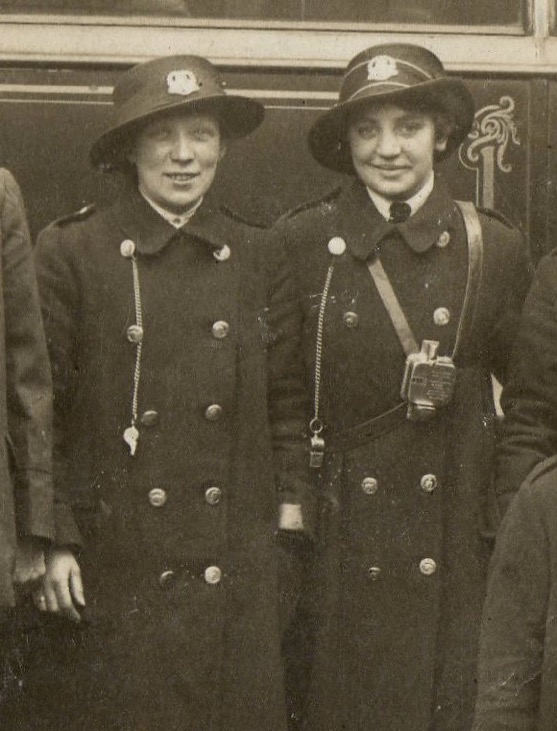
An enlargement of the above photograph showing two of the conductresses. Both of them are wearing double-breasted, lancer-style greatcoats, along with felt bonnets bearing a hat band with the standard 'tramways' cap badge.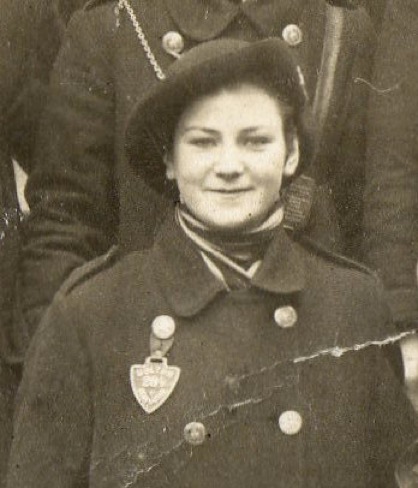
Another blow-up of the above photograph, this time showing one of the two ladies who are wearing Bolton 'shield-shaped' licence badges. These badges were normally worn by conductors and conductresses who worked for Bolton Corporation Tramways (see link), and are presumably being worn by the two Bury ladies because they were working on the through service between Bury and Bolton via Breightmet.